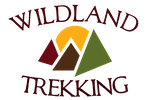
Hermit Loop
Flagstaff, AZ
Description
This deservedly very popular, point-to-point Grand Canyon hike off the South Rim is excellent for guests looking for a more remote, diverse and absolutely stunning tour of the Canyon. It features fantastic views, historic ruins, a canyon narrows section, and time at one (on the 4-day itinerary) or two (on the 5-day itinerary) of the more spectacular and more photographed rapids on the Colorado River. This is probably the most scenic hike in the Grand Canyon and offers tremendous natural and cultural diversity.
The first day takes us down the famous Bright Angel Trail past Havasupai Garden. From here we’ll hike west across the Tonto Trail, paralleling the Colorado River a thousand feet above it. The breathtaking views on this trip are punctuated by side hikes down narrow canyons to two impressive rapids on the river. We’ll enjoy majestic creek-side camps, desert wildlife viewing opportunities, ancient fossils, and some of the best hiking the Grand Canyon has to offer!
Important: It is strongly recommended to book your Grand Canyon backpacking trip 5 months in advance due to the Park’s permit system. Backpacking permits are issued on the first of the month 4+ months in advance (see deadlines for each month.) Permits for the most popular trips sell out very quickly during the initial lottery, so registering prior to the deadline of the month you’re interested in is highly beneficial. You can also pick any dates!
Please Note: Due to a temporary trail closure, this trip will be modified between December 1, 2023 and April 14, 2024. It will be operated as an out-and-back on the Hermit Trail. You can still expect the same breathtaking views, a visit to dramatic rapids on the Colorado River, amazing campsites and rejuvenating solitude! The difference is noted in the itinerary below.
| Trip Type: Guided Backpacking Trip |
Difficulty Level:
|
|
Solitude Level:
|
Group Size: 1-9 Guests |
| Trip Length: 4-5 Days | Distance: 29MI / 47KM |
|
Hiking Distances: 8-10 mi |
Backpack Weight: 35-45 lbs |
|
Terrain: Moderately Rugged |
Max Daily Elev. ↑↓: 3400 ft |
|
Heights Exposure: Moderate |
DIFFICULTY LEVEL 4
Scale of 1-5. 1 is least difficult; 5 is most difficult
This trip follows a mix of well maintained and more rugged trails. All but the final day are Level 3, but on the final day the trail is more rugged and we tackle significant elevation gains and longer distances. This trip is overall between 3 and 4, tending slightly toward 4.
Please Note: Terrain, Elevation Gain and Heights Exposure ratings reflect the section or day of the trip with the maximum difficulty of each. Much of the trip is at easier levels. See the trip itinerary for more detailed information. Backpack Weight ratings are estimates that account for Wildland-provided gear, guest clothing, personal items and a share of group food. By packing light it’s often possible to stay on the lower end of the weight range. Pack weights also decrease during the trip.
PHYSICAL DEMANDS OF THIS TRIP
- Hiking uphill or downhill with a 35-45 lb backpack for 6-8 hours
- Maintaining balance and footing on rugged terrain
- Hiking in 105+ degree farenheit ambient temps may be required in the warmer months (May-Sept). Learn more about desert heat.
- Hiking with moderate heights exposure
SOLITUDE LEVEL 3
1 least solitude, 5 most solitude
We rate this Grand Canyon hike a solitude 3 because it enters the Canyon on the most popular trail in the park (Bright Angel), but then follows the sparsely populated Tonto and Hermit Trails. You can expect hours of solitude at a time and often a feeling of having the Canyon to yourself.
Learn More about our Rating SystemWhat’s Included
- Top-of-the-line tent, backcountry sleeping pad and multi-day backpack
- High quality, synthetic sleeping bag (professionally laundered after every use) – or bring your own.
- Use of trekking poles and Microspike Crampons if necessary
- All meals are included from breakfast the first day through lunch on the last day
- A professional, knowledgeable, certified Grand Canyon hiking guide
- Roundtrip transportation from your hotel in Flagstaff, Arizona to the Grand Canyon and back
- Entrance fees and national park permits
- Emergency equipment including a company-issued first-aid kit and communication device (InReach Explorer or satellite phone)
- Mandatory 5% national park fee that passes through directly to Grand Canyon
What’s Not Included
- Clothes, raingear, and footwear (see recommendations)
- Sunscreen, toiletries and personal items
- Water bottles and a headlamp or flashlight
- Guide gratuity (industry recommendation is 10-20% of trip cost)
Grand Canyon Conservancy
 This trip specifically supports The Grand Canyon Conservancy, an official local partner of The Intrepid Foundation. The Intrepid Foundation is the non-profit arm of Wildland Trekking’s parent company, Intrepid Travel. The Foundation uses its local knowledge and connections to identify the issues that matter most and selects local partners like the Grand Canyon Conservancy to deliver serious solutions.
This trip specifically supports The Grand Canyon Conservancy, an official local partner of The Intrepid Foundation. The Intrepid Foundation is the non-profit arm of Wildland Trekking’s parent company, Intrepid Travel. The Foundation uses its local knowledge and connections to identify the issues that matter most and selects local partners like the Grand Canyon Conservancy to deliver serious solutions.
Your participation on this trip will directly support the work of the Grand Canyon Conservancy. Learn more about this partnership!
Day 1
- Shuttle to the South Rim: 1.5-hour drive from Flagstaff
- Hiking Mileage: 6.9 miles
- Elevation Loss: 3,060 feet
This memorable Grand Canyon backpacking tour begins with a 4.9-mile downhill hike on the Bright Angel Trail to Havasupai Garden, a Havasupai spring site that watered seasonal garden plots for centuries. At Havasupai Garden we’ll relax in the shade of the Cottonwood trees, dip our feet in the ice cold spring water of Garden Creek, and enjoy a peaceful picnic lunch before continuing to our first night’s camp. Tonight’s camp is a beautiful creek-side camp with wonderful solitude, where we’re guaranteed to be the only group since only one group is allowed per night.
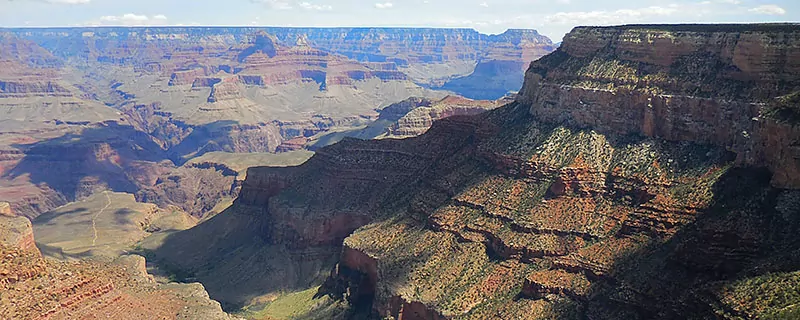
Day 2
- Hiking Mileage: 8.9 miles
- Elevation Gain: 800 feet
We’ll get an early start and begin our westward trek along the Tonto Plateau to Monument Creek. This is a long hike of almost 9 miles, but most of the route is on a well-groomed, relatively flat trail. Our hike takes us around the head of two large drainages: Salt and Horn Creek, and offers an abundance of classic, expansive views of the Grand Canyon, inner gorge, and Colorado River. Our destination for the night is Monument Creek, a cozy camp nestled beneath towering Redwall Limestone cliffs next to a trickling, spring-fed creek.
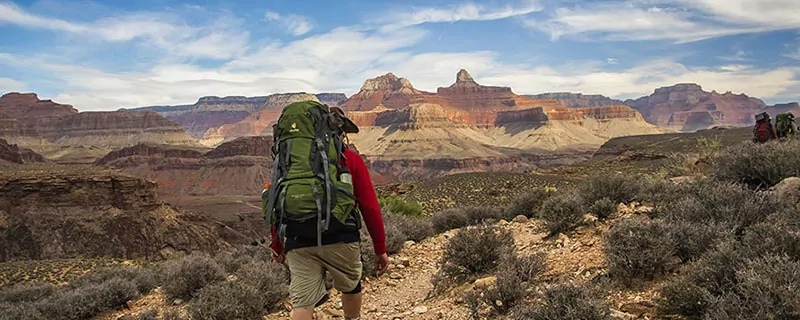
Day 3 (5-day Itinerary Only)
- Day Hike Hiking Mileage: 1.5 miles
- Day Hike Elevation Loss: 1,000 feet
Today we enjoy a relaxing morning, then break down camp and hike down Monument Creek to the Colorado River and Granite Rapids. This is a stunning hike through dramatic schist narrows, where we occasionally see bighorn sheep as a small population inhabits the area. Our destination, Granite Rapids, adds another level of drama to our day. This thundering, turbulent section of whitewater gives guests a taste of the power of the Colorado River. We’ll set up camp on the beach and enjoy a sunset dinner overlooking the rapids.
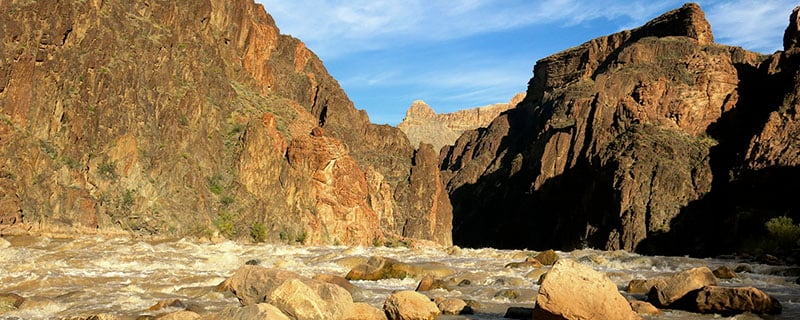
Second to Last Day
- Hiking Mileage: 4-8 miles
- Elevation Gain/Loss: 1200-2200 feet
We’ll get up reasonably early, eat and pack up. Today’s distance and elevation gain/loss vary depending on whether this is a 4-day or 5-day itinerary. Either way, we end up heading west to tonight’s camp along the charming desert oasis of Hermit Creek. As long as time and energy are abundant, we will set up camp and day hike to Hermit Rapid, an impressive white-water section of the Colorado River. After our day hike, we will return to camp for a final backcountry dinner to celebrate our last evening in the Canyon.
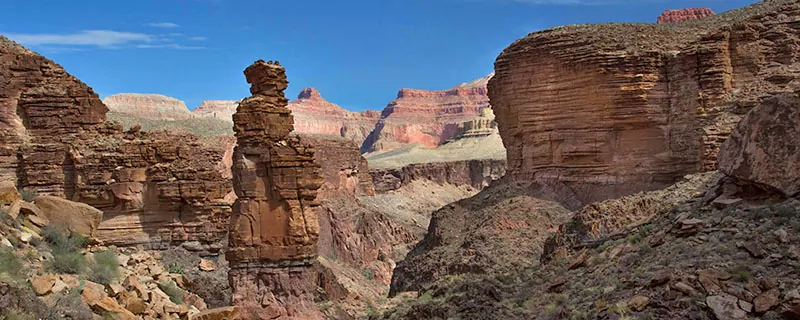
Final Day
- Hiking Mileage: 8 miles
- Elevation Gain: 3400 feet
- Shuttle to Flagstaff: 1.5 hours
The first mile of hiking takes us to the junction of the Tonto Trail and the Hermit Trail. At the junction we begin our ascent out of the Grand Canyon on the Hermit Trail. We’ll switchback throught the immense Redwall, then contour a series of shelves high above Hermit Creek. This section of hiking features increasingly stunning views of the Grand Canyon behind us. The last bit of hiking is on beautifully constructed, hand-fitted rock slabs – a true work of masonry art – and takes us past 250+ million year old footprint fossils that are some of the best in the Canyon. Once we reach the South Rim, we’ll shuttle back to the South Rim Village where our shuttle awaits us.
Modified Itinerary: 12/1/2023 - 4/14/2024
Due to a temporary trail closure, this trip will be operated as an out-and-back on the Hermit Trail between December 1, 2023 and April 14, 2024. We will descend the Hermit Trail on Day 1 (8 miles, 3400 feet of elevation loss). We will then combine nights at Hermit Creek, Monument Creek and Granite Rapid (normal Days 3-5 on the itinerary) to create a beautiful experience of the bottom of the Grand Canyon and the Colorado River. You will visit at least one dramatic rapid on the river, camp by desert oases, and soak up rejuvenating solitude. We will then ascend back out the Hermit Trail, per the standard itinerary (8 miles, 3400 feet of elevation gain.)
Please Note: We always do everything in our power to follow the set itinerary, however it can change occasionally based on temporary access restrictions, weather, lodging/campground availability, guest ability/injury, natural events like fires and flooding, and other potential causes. Normal terms and conditions apply to trips with itinerary changes.
PACKING LISTS

Importance of Being Prepared
Your safety and enjoyment will depend on your level of preparedness. It is your responsibility to arrive with the items listed below. Our Gear Guide is a resource to find more information about these items and links to online options. If you have additional questions about what to pack, please ask your guide during the pre-trip contact (~10 days prior to the trip start date) or call our Adventure Consultants 7 days a week at 928-223-HIKE (4453).
Packing List Video
For more guidance on the packing list, we recommend watching our Wildland Packing List Video. A senior Wildland guide and outdoor retail expert walks us through each item with examples and insights. Click here to see the video.
STANDARD CLOTHING CHECKLIST
The following items are required for your trip unless otherwise noted. When packing, think layered clothing systems that work together and can be easily added or removed.
(GG) = Gear Guide: see for more info and links to product options
- Hiking Boots/Shoes – mid-weight, lug-soled, and ideally well broken in (Boots GG – Shoes GG)
(Note: buy your boots/shoes 1/2 size to 1 size larger than your street shoes to allow for feet swelling and thicker socks) - Secondary Footwear – supportive, lightweight, well-drained shoe or sport sandal for creek crossings and/or for camp comfort (Camp Shoes GG)
- Hiking Socks – one pair for every two days of your trip, plus an extra pair to sleep in. Hiking-specific padded socks, no cotton please! (Socks GG)
(Note: wearing thin liner socks under your hiking socks can help prevent blisters) - Sun Hat – wide brimmed hat or baseball cap/bandana combo (Sun Hats GG)
- Cotton T-shirts – 2 short and/or long sleeve cotton t-shirts.
(Note: April-October only. Cotton retains moisture and helps to cool the body down in hot, arid desert environments. Cotton shirts are critical garments in terms of safety and comfort in the hotter months.) - Hiking Shirt – 1 non-cotton, breathable long sleeve shirt (Shirts GG – Sun Hoodies GG)
(Note: long sleeve shirts provide better sun protection) - Warm Top – mid-weight sweater or pullover of wicking material such as merino wool, fleece or polypropylene (Mid Layer GG)
- Hiking Pants & Shorts – nylon pants AND shorts, zip-offs or leggings (Pants GG – Shorts GG)
- Rain Gear – waterproof jacket, breathable fabric such as Gore-Tex® or coated nylon. (Rain Coats GG)
ADDITIONAL CLOTHING (OCTOBER to April)
- Warm Hat & Gloves – lightweight beanie and light-to-mid weight fleece or wool gloves (GG)
- Additional Hiking Shirt – 1 additional non-cotton, breathable long sleeve shirt (Shirts GG – Sun Hoodies GG)
- Mid Layer Insulating Jacket – down-fill or synthetic-fill insulated “puffy” jacket or warm, heavy-weight fleece jacket (Mid Layers GG)
- Base Layer/Long Underwear – 1 pair of wicking tops and bottoms that are lightweight to midweight, synthetic wicking materials such as polyester, polypropylene, merino wool…etc. (Base Layer GG)
- Rain Pants – waterproof pants, breathable fabric such as Gore-Tex® or coated nylon. Look for side zippers that will allow you to pull them over your boots. (Rain Pants GG)
Important Note: Please, no cotton hiking clothes with the exception of the “Cotton T-shirts” section above (which are important!) Feel free to call us if you have any questions or you can reference our Gear Guide.
GEAR CHECKLIST
- Hydration System – 3+ liters capacity, either water bottles or bladder/hose system and an additional water bottle (Hydration Bladders GG)
(Note: We recommend always having a bottle with 1 liter of capacity as a back-up in case of a hydration system failure and to use while in camp) - Headlamp – preferably with an L.E.D. bulb that works with AA or AAA batteries (Headlamps GG)
(Note: always test your headlamp before trips, travel/pack without batteries in device, and for longer trips (4+ days) consider a spare bulb and 1 set of spare batteries) - Sunglasses, Sunscreen, Lip Balm
- 2 Bandanas
- Contact Lenses and Glasses – if you wear contact lenses, please also bring a pair of glasses – your contacts are likely to become dirty and may be difficult to clean
- Prescription Medication – please inform your trip leader of any medications you are taking
- 1-2 Face Masks (Recommended but Optional)
- Toiletries – small amounts, travel sizes and/or just what you need for the trip (important that they are small!)
- Money – for any shopping you would like to do and for consideration of tipping your guide
(Note: tipping is optional but appreciated, industry recommendation is 10-20% of your trip cost based upon the quality of your experience)
OPTIONAL ITEMS
- Personal Sleeping Bag – please see information about bringing your own below (Sleeping bags GG).
- Personal Trekking Poles – as a Wildland guest, you can enjoy a 20% discount off Leki trekking poles (reservation number required.) Click here for discount. Trekking poles are provided for guests who do not bring their own. (Trekking Poles GG)
- Swimsuit – only if swimming is an option on your trip, some guests prefer to swim in quick drying hiking clothes, sports bra, etc…
- Camp Pillow – lightweight, compressible and packable
(Note: many guests use their extra clothing in a stuff sack with a bandana as a pillowcase, and it works well) - Stuff Sacks – various sizes for better organization of clothing & gear, and/or to help create a camp pillow, etc.
(Note: A lightweight waterproof stuff sack can be extremely useful in wet conditions) - Support Braces – consider bringing any joint braces that may be currently needed or from past injuries (i.e. knee, ankle, elbow, etc…)
- Camp Reading Material – lightweight paperback book, magazine or small notebook/pen for journaling
- Cell Phone or Camera
- Spare Batteries – for camera, headlamp or other electronics
- Solar Charger or Charging Bank – small, lightweight devices to recharge electronics
- Vitamins & Supplements
- Quick Dry Towel – lightweight, compressible and packable – bandanas also work
BRINGING YOUR OWN SLEEPING BAG
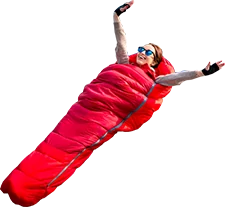 Some guests choose to bring their own sleeping bag. We supply high quality, synthetic fill bags that are professionally laundered after every trip. Synthetic fill is non-allergenic, insulates when damp and stands up well to repeated washings, but is heavier and bulkier than down. If you’re able to bring your own down sleeping bag, there are multiple benefits. If not, we’ve got you covered!
Some guests choose to bring their own sleeping bag. We supply high quality, synthetic fill bags that are professionally laundered after every trip. Synthetic fill is non-allergenic, insulates when damp and stands up well to repeated washings, but is heavier and bulkier than down. If you’re able to bring your own down sleeping bag, there are multiple benefits. If not, we’ve got you covered!
Planning to purchase a sleeping bag for your trip? See our sleeping bag suggestions on the Wildland Gear Guide.
SLEEPING BAG TEMPERATURE RATING NEEDED FOR THIS TRIP:
– Dec-Feb: 0° F
– Mar/Nov: 0°-20° F
– Apr/Oct: 20°-40° F
– May/Sept: 30°-50° F
– Jun-Aug: 50°-70° F
TRAVEL, TRANSPORTATION, MEETING & LODGING

MEETING TIME & PLACE
Unless we tell you otherwise, you will meet your guide and group at the Little America Hotel in Flagstaff for an orientation meeting at 5:00 PM the evening before the trip begins. We’re happy to give you a ride to this meeting if you’re not staying at Little America, but staying at one of our other recommended hotels. Your guide will then pick you up at your hotel the next morning for transport to the trailhead. For Private Grand Canyon Tours your guide will meet you at your hotel in Flagstaff at an agreed upon time.
TRIP CONCLUSION
This trip will conclude at approximately 5:00 PM on the last day.
ARRIVAL & DEPARTURE DATES
Travel to and from the trip starting point is not included in the cost of our trips. Please plan on arriving in time for the orientation meeting the day before the trip leaves and departing the day after getting back from the field.
GATEWAY CITIES:
Phoenix or Flagstaff, Arizona
This trip begins and ends in Flagstaff, Arizona. Flagstaff has a small airport served by Horizon and US Airways Express. From the Flagstaff Airport one can take a taxi into town. One can also fly into Phoenix and rent a car or take a shuttle to Flagstaff. This is often your cheapest option. It is a 2.5-hour drive from Phoenix to Flagstaff.
SHUTTLE FROM PHOENIX TO FLAGSTAFF
TRANSPORTATION TO & FROM THE TRAILHEAD
We will pick you up at your hotel room in Flagstaff early on the morning of the first day of the trip, and provide transportation back to your hotel in Flagstaff on the final day.
Please note: the Mule-assisted Classic and Phantom Ranch Tour rendezvous is at the South Rim of the Grand Canyon, and we do not provide transportation. Please see your trip description for details.
STORAGE OF PERSONAL ITEMS & VEHICLES
The best place to store your luggage and vehicle is at your hotel. If you stay at Little America (recommended), they offer free luggage and vehicle storage. The Drury Inn and Suites also provides this service for our guests. As a last resort, we have limited space for luggage storage at our warehouse and vehicles can be parked on the street in front of our office.
PRE & POST-TRIP ON REQUEST LODGING
We secure limited amounts of pre and post trip lodging in Flagstaff, Arizona as an optional add-on for guests of this trip. This lodging is on request, and is available on a first come, first serve basis. If interested, please reach out directly to our team to check availability.
PRE & POST-TRIP LODGING
Little America (location of On Request lodging and pre-trip orientation, vehicle/luggage storage)
Website / Phone: 928-779-2741
Drury Inn & Suites
Website / Phone: 928-773-4900
Sonesta Hotel (full kitchen in every room)
Website / Phone: 928-526-5555 ext 6005
Trip Insurance
We strongly recommend purchasing trip insurance. We designed our terms and conditions with trip insurance in mind. When you register for a trip, your spot is no longer available to other guests. Therefore, if you discover inside of 30 days (prior to your trip departure date) that you are unable to travel, no refund is available. With trip insurance, not only is your payment to Wildland covered, but your flights, hotels and other travel costs can also be insured.
Read more about our trip insurance recommendations.
CHECK THE WEATHER FORECAST FOR YOUR TRIP
We recommend using NOAA’s website (www.weather.gov) for the most accurate 5-day weather forecasts. There are two elevations to check when looking at Grand Canyon weather forecasts:
Please Note: this trip has the potential for 105+ degree Fahrenheit temperatures. Read more about hiking in the heat.

PACK WEIGHT AND CONTENTS
You will be hiking with a multi-day backpack that we provide. You’re also welcome to bring your own. The contents will be what you need for the trip – tent, sleeping bag, sleeping pad, clothing, rain gear, water, personal items, and a share of group food/gear.
ESTIMATED PACK WEIGHT: 35-45 POUNDS
Essential Eligibility Criteria
Essential Eligibility Criteria (“EEC”) have been specifically identified to help you understand the skills and abilities necessary to participate on each Wildland trip, and they apply uniformly to all potential trip participants, irrespective of the presence or absence of any disability.
Once you identify a trip in which you may be interested, please carefully review the EEC and itinerary details. If after reviewing the EEC that apply to your desired trip, you determine you need an accommodation in order to meet the EEC, please contact us prior to registering to discuss your requested accommodation.
The EEC exist for your own safety and the safety and enjoyment of all participants. If you are unable to meet the EEC for the trip, with or without an accommodation, you are not eligible for that trip. If you register and arrive for a trip for which you do not meet the EEC, you will be disqualified from participation on the trip and will be dismissed or evacuated from the trip without a refund.
TRAINING TIPS

The better shape you’re in the more fun you’ll have! We recommend very strongly that you train for your trip.
TRAINING BY HIKING
If you have access to hiking trails in hilly or mountainous terrain, this is the ideal way to train. If not, we recommend using the Stairmaster machine (with rotating stairs like an escalator) or actually training on stairs. Nothing prepares you for a trip better than the activity itself!
Train at least 3 days a week. Start with short hikes or workouts (1-hour in length) with a light daypack. From week to week build the length and intensity of your hikes/workouts and gradually increase your pack weight until you’re comfortably able to hike 6-8 hours a day carrying the weight you’ll have on your trip. It’s best to begin your training regimen at least 12 weeks prior to your trip. Also be sure to use the boots you’ll have on your trip to break them in.
Following is how a program may look:
| First Week | Work Up To |
| Tuesday: 1-hour hike/workout with daypack Thursday: 1-hour hike/workout with daypack Sunday: 2-hour hike/workout with daypack |
Monday: 2-3 hour hike/workout with daypack Wednesday: 2-3 hour hike/workout with daypack Thursday: 2-3-hour hike/workout with daypack Sunday: 7-hour hike with the weight you’ll have on your trip |
SUPPLEMENTAL TRAINING IDEAS
There are many other activities that are easily incorporated into your daily life to build your overall fitness. Cross training is important to strengthen opposing muscle groups and it helps to avoid over-use injuries. Supplemental training ideas include:
- Bike to work or when running errands.
- Gym activities including step aerobics, treadmill, bicycling, or elliptical trainers to name a few. A modest weight training program focusing on the muscles that support the ankles, knees, back, and shoulders is also beneficial.
- Swimming is a great way to build endurance and cardiovascular fitness and is easy on the joints.
- Walk to work instead of driving. Run your errands by walking and carry your groceries home in a backpack.
- Yoga and/or Pilates classes can build strength throughout your body while also improving your flexibility.
- Intramural sports
- Jogging is another option, however if you are not a regular runner it can easily lead to injuries that backpacking may then exacerbate. Undertake a jogging routine with care.
FLEXIBILITY AND HYDRATION
Flexibility is an important part of training. Remember to stretch before and after your workouts. For the two weeks leading up to your trip cut your workouts in half to avoid arriving fatigued. Also for a 72-hour period before your trip commences, ensure that you are consuming sufficient amounts of sodium and fluids. Doctors agree that hikers increase the likelihood of experiencing problems if they are sodium depleted (e.g., follow a low sodium diet) or are dehydrated (due to travel or using diuretics such as coffee or alcohol).
Important note: Always consult with your physician before commencing with a workout program.
GROUP TRAVEL

If you’re joining one of our scheduled trekking tours you’ll be hiking with fellow outdoor enthusiasts. Please carefully examine the trip materials and difficulty level prior to registering to select a trip that matches your ability level. If you need assistance selecting the right trip we are more than happy to help.
We make every effort to accurately set expectations and effectively screen guests, however it is inevitable on some trips there will be a discrepancy in fitness levels. Consider that the trip may be a once in a lifetime opportunity for your fellow travelers and it is important to respect each guest’s individual condition, needs and desires.
Finally, guided groups are required by land management agencies to stay together on the trail. Hiking together can require patience and flexibility. If hiking at a very specific pace is extremely important to you, you may want to consider booking a private trip.
 Tipping Your GUide
Tipping Your GUide
Tipping your guide is greatly appreciated! Wildland guides, and outdoor/backcountry guides in general, do much more than lead guests down the trail. Although supported by amazing in-town staff, they often work independently in the field due to permit and logistical constraints. The guide is responsible for the group’s safety, menu planning (including dietary restrictions), cooking for the group, prepping and taking care of the gear, handling livestock (on stock-supported trips), driving, complying with government regulations, ensuring guest satisfaction, and generally making sure the tour runs smoothly. They wear many hats and are extraordinary at what they do!
The industry standard tip amount for hiking and backpacking guides is between 10% and 20% of the tour cost per person, depending on your level of satisfaction. If you have any questions about tipping, feel free to call us 7 days a week at 800-715-HIKE (4453)!

GUIDE SHIFTS
Guides are required to take 8 hours off each 24-hour period to sleep, recuperate, take personal/down time…etc. In addition, as part of the 8 hours off they must sleep/rest or be in their tents/rooms uninterrupted for a minimum of 5 hours each night. We ask guests to respect these requirements and to not interrupt guides’ off time and sleep time unless there is a true emergency.
Grand Canyon Maps
Grand Canyon National Park requires guide companies to provide every guest access to a map of the area(s) we’ll be hiking. You’ll find the map link(s) below. If you’d like, you can download and print or download to your phone for access during the trip. Your guide will also have a high quality, detailed, waterproof topographical map that you can reference out on the trail.

Thank You! The Wildland Trekking Company is dedicated to delivering an exceptional travel experience that exceeds your every expectation. We believe travel and adventure are two of life’s great joys and take seriously our role in helping you create a trip of lasting memories. In addition to our role as your travel partner and outfitter we are dedicated to the promotion of stewardship and conservation in the regions we visit. One of our commitments is to use Wildland as a tool toward long-term sustainability of the Earth’s environment and its communities. If there is anything we can do to further inform or help you prepare for your upcoming adventure please do not hesitate to contact us. Thanks for the opportunity to serve you and we look forward to seeing you soon!

800-715-HIKE (4453)
Feel free to call us for more info – we’re here 7 days a week!

